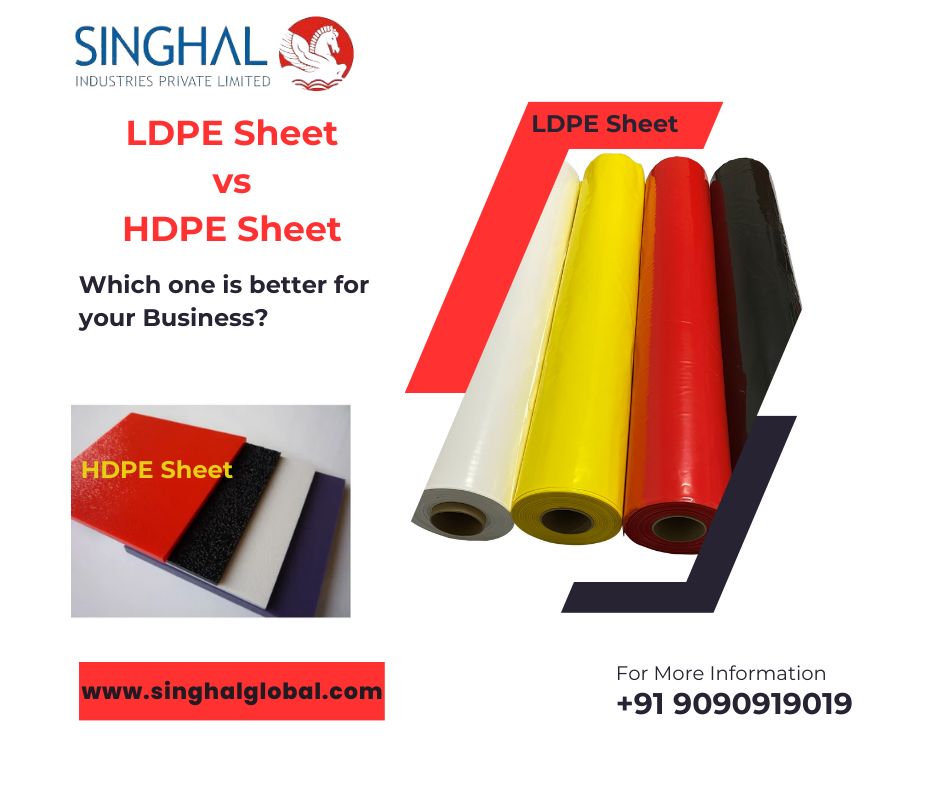There are five types of Polyethylene, but the two most common forms are Low-density polyethylene (LDPE) and High-density polyethylene (HDPE) in industries as well as other businesses.
Both these types have their unique characteristics, similarities, and differences, which this article entails. So, read it in its entirety to be enlightened and choose the best LDPE sheet or HDPE Sheet for your project henceforth. We have shared all the points accordingly in below table you can see on what basis we have compared the HDPE & LDPE Sheets.
LDPE vs HDPE Sheets on Below Points
If you are in confusion that which is better HDPE or LDPE Sheet? Than we have describe about the same for your help and below are some points which will help you to understand what is the difference between LDPE and HDPE sheet?
| Melting Point | Flexibility |
| Tensile Strength | Transparency |
| Tensile Elongation | Heat Resistance |
| Flexure Modulus | Chemical Resistance |
| Density | Production |
| Coefficient of Friction | Molecular Structure |
| Chemical Structure | Recyclability |
| Use Case |
Melting Point
While the melting point of LDPE ranges between 105 and 115°C or 221 and 239°F, that of the HDPE, in comparison, is 135°C or 275°F.
Tensile Strength
The two products also differ in their respective tensile strength. LDPE has a tensile strength of 1,400 psi or 9.65 MPa compared to 4,000 psi or 27.47 MPa of HDPE.
Tensile Elongation
LDPE and HDPE can also be differentiated on their tensile elongation properties. It is 500 psi or 3.44 MPa for the former and 600 psi or 4.13 MPa for the latter.
Flexure Modulus
The flexural property of the LDPE plastic sheet, which is 30,000 psi or 206.84 MPa, and HDPE, which is 200,000 psi or 1378.59 MPa, is also a parameter to differentiate the two products.
Density
The density of the two products is slightly different as well. While that of LDPE ranges between 0.910 and 0.940 g/cm3 or 910 and 940 Kg/m3, that of HDPE is 0.93 to 0.97 g/cm3 or 930 to 970 kg/m3.
Coefficient of Friction
The coefficient of friction of LDPE ranges between 0.12 and 0.70. On the other hand, that of HDPE is 0.200 and 0.280.

Chemical Structure
The chemical structure used to make the LDPE sheet for construction varies significantly from HDPE. Ideally, the chemical structure of LDPE is more branching than HDPE’s, which is more linear.
Flexibility
LDPE is more flexible when compared to HDPE due to its low crystallinity of around 50 to 60% compared to 90% of HDPE.
Transparency
The amorphous nature of LDPE makes it more transparent than HDPE, which is more crystalline.
Heat Resistance
The heat-resisting ability of the LDPE is relatively less than that of HDPE, being just 20°C as against over 100°C of the latter.
Chemical Resistance
The LDPE sheets are resistant to alcohols and diluted acids, and alkalis. However, it is not resistant to aromatic and aliphatic hydrocarbons, halogenated hydrocarbons, mineral oils, or oxidizing agents.
The gas permeability of LDPE is also very high for specific gases, such as carbon dioxide, and its UV resistance property is pretty low.
On the other hand, HDPE is highly resistant to almost all solvents, alcohols, diluted alkalis, and acids. It is relatively more resistant to greases and oils.
Production
The LDPE sheet manufacturer uses high pressure to make the sheets, often ranging between 1000 and 3000 bar at 80 to 300°C, using the free fundamental polymerization method.
Moreover, other manufacturing processes of LDPE sheets include ethylene gas compression, gas separation, and material polymerization. An initiator, tubular reactor, or stirred autoclave is often used to produce LDPE.
On the other hand, HDPE is produced by either gas-phase or slurry polymerization or ethylene monomer solution and then by separating and drying them.
The entire process of HDPE production involves different methods, such as linear chain reaction of polymers and heat application to break the hydrocarbons into ethylene monomers.
After that, the slurry is cleaned, extracted, filtered, and dried for further purification and processing.
Molecular Structure
The molecular structure of LDPE is more loosely packed. This offers more flexibility and density. This also makes it easy to process the Low-density polyethylene sheets, reduces the melting point, and allows more resistance to stress and cracks.
On the other hand, the molecules of HDPE are more tightly packed, offering it more density, stiffness, and strength. However, due to the linear nature of the structure of molecules, it has a higher stability and melting point.
Recyclability
Though both are recyclable, LDPE has a higher recycling number than HDPE, being 4 as against 2. It largely depends on the product.
This means that LDPE is pretty difficult to recycle due to its softness, while HDPE is not that hard due to its hardness.
Use Cases
Both LDPE and HDPE differ in use cases as well.
The LDPE sheets are primarily used for the following:
- Plastic bottles
- Wash bottles
- Light materials
- Computer hardware
People also buy sheets from the LDPE sheet suppliers to use as an additional layer to protect the work surfaces.
On the other hand, HDPE is used mainly for the following:
- Pipes and fittings
- Automotive parts
- Chairs and tables made from plastic
- Parts of a boat
- Recycling or trash bins
- Toys
- Ice cube containers
- Industrial fabrics
- Fibers to make ropes and nets
HDPE is also used as a packing material for milk bottles and caps made from plastic, bulk drums, and containers for industries.
Conclusion
Both low-density polyethylene sheets and high-density polyethylene sheets have several uses and benefits. However, both are not created equal and have a lot of differences in their physical and chemical properties.
Now that you know them, choosing the best sheet to suffice all your packaging needs should be easy and you can contact Singhal Industries Pvt. Ltd. for both kind of sheets.









